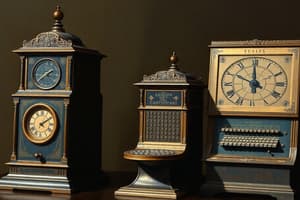Podcast
Questions and Answers
Which component of a computer is responsible for performing calculations and processing instructions?
Which component of a computer is responsible for performing calculations and processing instructions?
- Power Supply
- Input Devices
- Motherboard
- Central Processing Unit (CPU) (correct)
Which of the following devices is categorized as an output device?
Which of the following devices is categorized as an output device?
- Mouse
- Scanner
- Keyboard
- Printer (correct)
What type of memory is considered temporary and is used for active processes in a computer?
What type of memory is considered temporary and is used for active processes in a computer?
- RAM (Random Access Memory) (correct)
- Hard Disk Drive
- ROM (Read-Only Memory)
- USB Flash Drive
Which of these is not a type of malware?
Which of these is not a type of malware?
What function does the motherboard perform in a computer?
What function does the motherboard perform in a computer?
Flashcards are hidden until you start studying
Study Notes
History Of Computers
-
Early Mechanical Devices:
- Abacus (3000 BC): First counting device.
- Charles Babbage (1837): Designed the Analytical Engine, a mechanical general-purpose computer.
-
First Generation (1940s-1950s):
- Vacuum tubes used for circuitry.
- ENIAC and UNIVAC: Early electronic computers.
-
Second Generation (1950s-1960s):
- Transistors replaced vacuum tubes.
- Improved reliability and efficiency.
-
Third Generation (1960s-1970s):
- Integrated Circuits (ICs) introduced.
- Miniaturization of components.
-
Fourth Generation (1970s-Present):
- Microprocessors developed.
- Personal computers emerged.
-
Fifth Generation (Present and Beyond):
- Focus on artificial intelligence and advanced computing.
Operating Systems
-
Definition: Software that manages hardware and provides services for computer programs.
-
Types of Operating Systems:
- Batch Operating Systems: Processes jobs in batches without user interaction.
- Time-Sharing Operating Systems: Multiple users can access the system simultaneously.
- Distributed Operating Systems: Manages a group of distinct computers and makes them appear as a single entity.
- Embedded Operating Systems: Designed for specific applications, often with real-time constraints (e.g., in machines or devices).
-
Examples:
- Microsoft Windows
- macOS
- Linux
- Android
- iOS
Computer Software Types
-
System Software:
- Includes operating systems and utilities that manage hardware.
- Example: Windows, macOS.
-
Application Software:
- Programs that perform specific tasks for users.
- Types include:
- Productivity Software (e.g., Microsoft Office)
- Database Software (e.g., Oracle, MySQL)
- Graphic Design Software (e.g., Adobe Photoshop)
- Web Browsers (e.g., Chrome, Firefox)
-
Development Software:
- Tools for creating software applications.
- Examples: IDEs (e.g., Visual Studio), Compilers (e.g., GCC).
-
Malware:
- Malicious software designed to harm or exploit computers.
- Types include viruses, worms, trojan horses.
Basic Computer Components
-
Input Devices:
- Allow users to enter data (e.g., keyboard, mouse, scanner).
-
Output Devices:
- Display or output data (e.g., monitor, printer, speakers).
-
Central Processing Unit (CPU):
- The brain of the computer; performs calculations and processes instructions.
-
Memory:
- RAM (Random Access Memory): Temporary storage for active processes.
- ROM (Read-Only Memory): Permanent storage for firmware.
-
Storage Devices:
- Store data permanently (e.g., Hard Disk Drives, Solid State Drives, USB flash drives).
-
Motherboard:
- Main circuit board connecting all components of the computer.
-
Power Supply:
- Converts electricity from an outlet into usable power for the computer components.
History Of Computers
- Abacus (3000 BC) is recognized as the first counting device.
- Charles Babbage designed the Analytical Engine in 1837, considered a pioneering mechanical general-purpose computer.
- First Generation (1940s-1950s) utilized vacuum tubes for circuitry, with notable computers like ENIAC and UNIVAC.
- Second Generation (1950s-1960s) introduced transistors, enhancing reliability and efficiency.
- Third Generation (1960s-1970s) brought Integrated Circuits (ICs), leading to component miniaturization.
- Fourth Generation (1970s-Present) featured the development of microprocessors and the rise of personal computers.
- Fifth Generation (Present and Beyond) focuses on artificial intelligence and advanced computing technologies.
Operating Systems
- Operating systems are software that manage computer hardware and provide essential services for applications.
- Batch Operating Systems process jobs in groups without user interaction.
- Time-Sharing Operating Systems allow multiple users simultaneous access to a computer system.
- Distributed Operating Systems manage a network of computers, presenting them as a single unit.
- Embedded Operating Systems are designed for specific applications, often with real-time constraints.
- Examples of operating systems include Microsoft Windows, macOS, Linux, Android, and iOS.
Computer Software Types
- System Software manages hardware and includes operating systems and utilities, e.g., Windows and macOS.
- Application Software performs specific user tasks, categorized into:
- Productivity Software (e.g., Microsoft Office)
- Database Software (e.g., Oracle, MySQL)
- Graphic Design Software (e.g., Adobe Photoshop)
- Web Browsers (e.g., Chrome, Firefox).
- Development Software includes tools for creating applications, such as Integrated Development Environments (IDEs) like Visual Studio and Compilers like GCC.
- Malware refers to malicious software that can exploit or damage computers, with types including viruses, worms, and trojan horses.
Basic Computer Components
- Input Devices (e.g., keyboard, mouse, scanner) allow users to enter data into the system.
- Output Devices (e.g., monitor, printer, speakers) display or output information.
- Central Processing Unit (CPU): Known as the brain of the computer, it executes calculations and processes instructions.
- Memory components include:
- RAM (Random Access Memory): Temporary storage for currently running processes.
- ROM (Read-Only Memory): Permanent storage for firmware.
- Storage Devices (e.g., Hard Disk Drives, Solid State Drives, USB flash drives) retain data long-term.
- The Motherboard is the main circuit board that connects all computer components.
- Power Supply transforms electricity from an outlet into power usable for computer components.
Studying That Suits You
Use AI to generate personalized quizzes and flashcards to suit your learning preferences.




